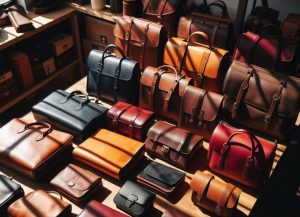Eco-Friendly Leather Bags Through Sustainable Farming

Sustainable practices are transforming leather bag production. Traditionally, leather bags had a considerable environmental impact, but today’s trend towards eco-friendly methods is changing that. This shift is closely linked to sustainable farming and agricultural practices. Here’s a look at how authentic leather bags are being crafted with a focus on sustainability.
The production of leather bags begins long before the crafting process. It starts with farming and agriculture. Sustainable farming practices play a crucial role in ensuring that the leather used in bags is eco-friendly. Here’s how:
- Regenerative Agriculture: Some leather producers are sourcing their raw materials from farms that practice regenerative agriculture. This method improves soil health, enhances biodiversity, and reduces carbon emissions. By supporting these farms, leather bag companies are indirectly contributing to a healthier planet.
- Ethical Sourcing: Leather bags made from ethically sourced hides come from farms where animals are raised under humane conditions. These farms often adhere to strict environmental and welfare standards, ensuring that the leather production process has a minimal negative impact on the environment.
- Waste Reduction: Some leather bag manufacturers are using leather from by-products of the meat industry. This practice helps in reducing waste and makes use of materials that would otherwise go to waste.
Eco-Friendly Leather Production Methods
The tanning process, which turns raw hides into usable leather, is one of the most critical stages in leather production. Traditional tanning methods often involve toxic chemicals and significant water use. However, eco-friendly alternatives are becoming more common:
- Vegetable Tanning: This method uses natural tannins from plants, such as oak or chestnut, instead of harmful chemicals. It’s a slower process but results in leather that is more durable and less polluting.
- Chrome-Free Tanning: For those who prefer quicker tanning methods, chrome-free options are available. These methods use non-toxic substances and are less damaging to the environment compared to traditional chrome tanning.
- Recycled Leather: Another innovative approach is using recycled leather. This involves reprocessing old leather goods into new products, reducing the need for new raw materials, and cutting down on waste.
The Benefits of Eco-Friendly Leather Bags
Choosing eco-friendly leather bags offers several benefits beyond just environmental impact:
- Durability: Eco-friendly leather tends to be more durable, which means the bags last longer. This reduces the need for frequent replacements and contributes to a more sustainable lifestyle.
- Unique Aesthetic: Leather bags made using sustainable methods often have a unique look and feel. The natural tanning processes and recycled materials can result in distinctive textures and colors that are different from conventionally produced leather.
- Supporting Ethical Practices: By choosing eco-friendly leather bags, consumers support ethical farming and production practices. This helps in promoting animal welfare and environmental conservation.
Leading Brands in Sustainable Leather Fashion
Several brands are leading the way in sustainable leather fashion. These companies are committed to using environmentally friendly practices and supporting ethical farming. Some examples include:
- Patagonia: Known for its commitment to environmental sustainability, Patagonia offers leather products made from responsibly sourced hides and uses vegetable tanning methods.
- Matt & Nat: This brand focuses on cruelty-free and eco-friendly materials. They use recycled leather and aim to minimize their environmental footprint.
- Fjällräven: Fjällräven uses leather from ethical sources and employs environmentally friendly tanning methods. They are dedicated to reducing their overall environmental impact.
How Consumers Can Make a Difference
Consumers play a vital role in promoting sustainable practices in the leather industry. Here’s how you can contribute:
- Research Brands: Look for brands that prioritize sustainability and ethical practices. Check their sourcing methods and production processes to ensure they align with your values.
- Invest in Quality: Choose high-quality, durable leather bags that will last longer. Investing in well-made products reduces the need for replacements and supports sustainable fashion.
- Care for Your Leather Bags: Proper maintenance extends the life of your leather bags. Follow care instructions to keep them in good condition and avoid unnecessary waste.
The rise of eco-friendly leather bags is a positive development in the fashion industry. By linking sustainable farming practices with innovative leather production methods, the industry is making progress toward reducing its environmental footprint. Consumers have the power to support these changes by choosing ethical and sustainable products, contributing to a healthier planet and a more responsible fashion industry.

